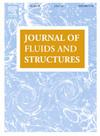The mechanism of galloping control with a passive modal controller
IF 3.4
2区 工程技术
Q1 ENGINEERING, MECHANICAL
引用次数: 0
Abstract
Passive modal controllers (PMC) are widely used in vibration control. However, the mechanism of PMC in galloping control is still unclear due to the limitation of the present quasi-steady theory. The motivation of this study is to reveal the dynamic mechanism of PMC in galloping control at a low Reynolds number () via linear stability analysis (LSA) based on the unsteady aerodynamic model. The reduced-order model (ROM) of unsteady flow is identified using the autoregressive with exogenous input (ARX) technique based on the Navier–Stokes equations. Direct numerical simulations are utilized to support relevant results. It is found that the PMC transforms the unstable structural mode into the stable one due to the modal coupling effect. That is the reason for suppressing significant galloping vibration and eliminating the frequency lock-in phenomenon. The results obtained from dynamic mode decomposition (DMD) indicate that the PMC does not directly affect the unsteady vortex shedding, but changes the coupling mode and stability characteristics of the original coupled system. Thus, the second dominant mode of the flow field which is referred to as galloping mode is replaced with the second harmonic vortex shedding mode. Finally, a parametric study is conducted on the galloping control with a PMC from the perspective of system stability. The ROM-based LSA can provide the effective parameter range for PMC design.

无源模态控制器的驰动控制机理
被动模态控制器(PMC)在振动控制中有着广泛的应用。然而,由于现有准稳态理论的限制,PMC在驰动控制中的作用机理尚不清楚。本研究的目的是通过基于非定常气动模型的线性稳定性分析(LSA),揭示PMC在低雷诺数(Re)下驰骋控制的动力学机制。基于Navier-Stokes方程,采用带外源输入的自回归方法对非定常流场的降阶模型(ROM)进行辨识。直接数值模拟用于支持相关结果。研究发现,由于模态耦合效应,PMC将不稳定结构模态转变为稳定结构模态。这就是抑制显著驰振和消除频率锁定现象的原因。动态模态分解(DMD)结果表明,PMC不直接影响非定常旋涡脱落,但改变了原耦合系统的耦合模式和稳定性特性。因此,流场的第二主导模式,即所谓的驰骋模式被第二谐波涡脱落模式所取代。最后,从系统稳定性的角度对PMC的驰动控制进行了参数化研究。基于rom的LSA可以为PMC设计提供有效的参数范围。
本文章由计算机程序翻译,如有差异,请以英文原文为准。
求助全文
约1分钟内获得全文
求助全文
来源期刊

Journal of Fluids and Structures
工程技术-工程:机械
CiteScore
6.90
自引率
8.30%
发文量
173
审稿时长
65 days
期刊介绍:
The Journal of Fluids and Structures serves as a focal point and a forum for the exchange of ideas, for the many kinds of specialists and practitioners concerned with fluid–structure interactions and the dynamics of systems related thereto, in any field. One of its aims is to foster the cross–fertilization of ideas, methods and techniques in the various disciplines involved.
The journal publishes papers that present original and significant contributions on all aspects of the mechanical interactions between fluids and solids, regardless of scale.
 求助内容:
求助内容: 应助结果提醒方式:
应助结果提醒方式:


